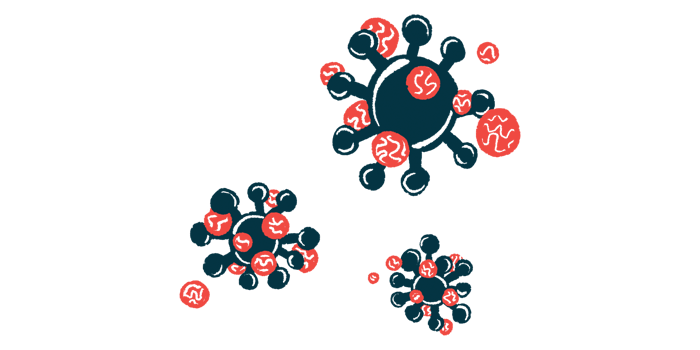NLRP3 inhibition alone does not ease ALS inflammation: Study
Researchers examine impacts of specific NLRP3 inhibition in cell and animal models

Inhibiting the NLRP3 inflammasome — an immune system protein complex believed to contribute to the inflammation that drives amyotrophic lateral sclerosis (ALS) — alone was not sufficient to ease spinal cord inflammation in a mouse model of the disease, according to recent research.
NLRP3 is overactive in ALS and has been a focus of therapeutic development, but there are other inflammasome complexes that could be involved.
ZyVersa Therapeutics believes the study findings support its development of inflammasome inhibitors that target multiple pathways — not just NLRP3 — to control inflammation in ALS and other inflammatory diseases.
“The research … reinforces the need to inhibit more than the NLRP3 inflammasome pathway to control inflammation associated with activation of multiple inflammasomes,” Stephen C. Glover, co-founder, chairman, CEO and president of ZyVersa, said in a press release.
The study, “Divergent functional outcomes of NLRP3 blockade downstream of multi-inflammasome activation: therapeutic implications for ALS,” was published in Frontiers in Immunology. It was funded by UCB BioPharma and all study authors are UCB employees.
Inflammasomes are protein complexes that sense threats (i.e., microbes or other foreign molecules) and respond by inducing inflammatory attacks against them. Their excessive activation can contribute to the chronic inflammation that’s involved in a wide range of diseases.
Understanding inflammasomes
There are several types of inflammasomes in the body. Each contains a unique sensor molecule that responds to different environmental threats.
That sensor binds to ASC, a protein that recruits caspase-1, which initiates the production of pro-inflammatory molecules called cytokines and inflammatory cell death, or pyroptosis. Additional ASC molecules gather and form structures called specks that are critical for perpetuating cytokine release.
The most widely studied inflammasome in the context of neurological diseases is the type that contains the NOD-Like Receptor Family Pyrin Domain Containing 3 (NLRP3) sensor molecule.
Indeed, a growing body of evidence indicates that activation of NLRP3 contributes to inflammation and nerve cell death in ALS. As such, it is being investigated as a potential therapeutic target for the neurodegenerative disease.
Yet, evidence suggests that other inflammasome types also are dysregulated in ALS and other neurological diseases. As such, ZyVersa believes that targeting NLRP3 alone may not be enough to dampen inflammation in these conditions.
Investigational antibody IC 1oo inhibits the ASC protein
The company is developing IC 1oo, an investigational antibody that inhibits the ASC protein. Because ASC is integral to the formation and function of multiple inflammasome types, including NLRP3, its blockade could inhibit the initiation of inflammatory signaling across multiple disease-associated complexes.
“ZyVersa’s Inflammasome ASC inhibitor IC 100 is designed to inhibit formation of multiple types of inflammasomes to attenuate initiation of the inflammatory cascade, and to inhibit ASC specks to attenuate perpetuation of damaging inflammation,” Glover explained.
IC 100 has been found to suppress inflammation in preclinical studies, including in models of multiple sclerosis, age-related inflammation, Alzheimer’s disease, traumatic brain injury, and spinal cord injury.
In the study, scientists examined the impacts of specific NLRP3 inhibition in various cell and animal models of ALS. Various immune cell types from healthy people and ALS patients were exposed to inflammatory stimuli meant to activate the NLRP3 inflammasome.
Genetic or pharmacological NLRP3 inhibition in these cells led to reduced release of cytokines and less pyroptosis. However, in cells stimulated to activate other inflammasome complexes, the NLRP3 inhibitor, called MCC950, led to variable responses in terms of cytokine release or pyroptosis.
In healthy mice and an ALS mouse model, MCC950 also was able to block NLRP3-induced pyroptosis, but it failed to prevent cell death induced by other types of inflammasomes.
Notably, in a mouse model of ALS, NLRP3 inhibition alone was not sufficient to ease spinal cord inflammation.
Limitations of NLRP3 inhibition
“Our study highlights potential limitations of NLRP3 inhibition in attenuating cytokine release and inflammatory cell death when other inflammasomes are active,” the researchers wrote.
“As such we suggest future therapeutic focus in neurological indications with multi-inflammasome activation should be on converging executer nodes downstream of inflammasomes, rather than single inflammasome-inhibiting approaches,” they added.







